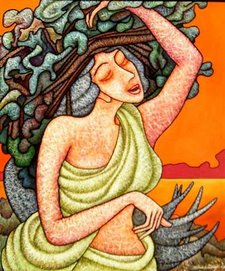
Driving to the airport and back, I always wait to pass by a strange looking building in Heliopolis. Strange looking, not because it’s grotesque or weird, but because it is so un-Egyptian in its construct and carvings. My driver was clueless and was of little help so as to the name or the origins of this amazing structure.
It looks like an ancient Indian temple - an Indian temple in the middle of Islamic Egypt? The paradox kept bothering me, so I decided to pay the structure / temple / monument a visit.
On reaching the monument, I discovered that it was a palace - the Baron Empain palace, (Qasr Al- Baron), one of Egypt’s most spectacular architectural masterpieces, a place which has always been, and remains to be, a subject of fables, legends and rumors. And guess what the palace is known as? The Baron's Hindu Palace! So I was right about the Indian temple bit!
In 1904, Belgian Baron Edward Louis Joseph Empain first arrived in Egypt with only one intention: rescuing his company’s project to construct a railway line connecting Matariya to Port Said. Although the mission failed and he lost the contract to the British, he made up his mind to stay in Egypt. It is said that the Baron had fallen in love. But no one knew whether it was with the desert or one of the Egypt’s most beautiful elites (much is talked about his love and affection for Yvette Boghdadli).
The Baron is credited with building the new city of Heliopolis, ten miles from Cairo.
Baron Empain commissioned his palace in 1907, two years after work began on the construction of Heliopolis. Empain asked French architect Alexander Marcel to build him a Hindu palace on an artificial elevation. It was completed in 1911.
The elaborate interior was the responsibility of his French associate, Georges-Louis Claude.
ANGKOR WAT
It looks like an ancient Indian temple - an Indian temple in the middle of Islamic Egypt? The paradox kept bothering me, so I decided to pay the structure / temple / monument a visit.
On reaching the monument, I discovered that it was a palace - the Baron Empain palace, (Qasr Al- Baron), one of Egypt’s most spectacular architectural masterpieces, a place which has always been, and remains to be, a subject of fables, legends and rumors. And guess what the palace is known as? The Baron's Hindu Palace! So I was right about the Indian temple bit!
In 1904, Belgian Baron Edward Louis Joseph Empain first arrived in Egypt with only one intention: rescuing his company’s project to construct a railway line connecting Matariya to Port Said. Although the mission failed and he lost the contract to the British, he made up his mind to stay in Egypt. It is said that the Baron had fallen in love. But no one knew whether it was with the desert or one of the Egypt’s most beautiful elites (much is talked about his love and affection for Yvette Boghdadli).
The Baron is credited with building the new city of Heliopolis, ten miles from Cairo.
Baron Empain commissioned his palace in 1907, two years after work began on the construction of Heliopolis. Empain asked French architect Alexander Marcel to build him a Hindu palace on an artificial elevation. It was completed in 1911.
The elaborate interior was the responsibility of his French associate, Georges-Louis Claude.
ANGKOR WAT

Marcel and Claude had previously constructed and decorated the Oriental Pavilion attached to the Royal Palace of Laeken in Belgium. The palace was set in a marvelous garden - ascending green terraces, each with its own set of erotic marble statues.
The palace architecture is of a cross-cultural nature with an extraordinary mixture of Hindu temples of Orissa, Renaissance architecture along Marcel’s own adaptation of the Cambodian temples in Angkor Wat.
ORISSA HINDU TEMPLES

The Baron died at Woluwe, Belgium, and was buried under the basilic of Notre-Dame d'Héliopolis , and, with his death, began the ruin of this magnificient building.
The palace that was built by the hands of the best Indonesian artists and sculptors has sadly been allowed to fall to ruin.
The Egyptian army requisitioned the building during the Tripartite Aggression, which further damaged the garden and interior.
Over the years, the Baron palace has become a subject of many rumours, and, tales - the palace was haunted, it was used by devil worshippers and, perhaps more credibly, by drug dealers.
The palace was sold by the Baron’s family in 1957 to the families of Alxasam and Reda and was declared a monument later in the 80s by the Egyptian government.
But, a trip to Egypt would not be complete without a visit to this beautiful structure, still so majestic and unique in its construct, in this country of tombs and pyramids.

No comments:
Post a Comment